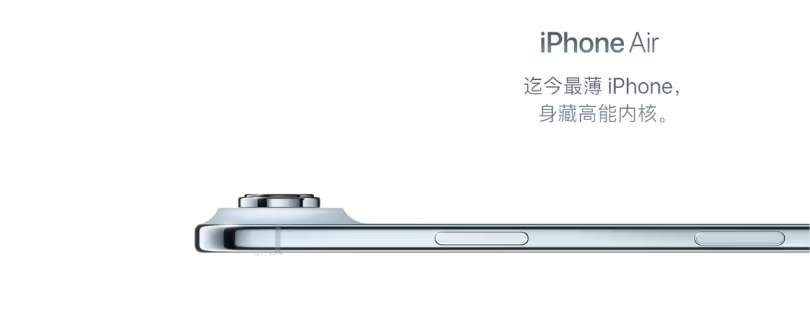
Apple Brings eSIM Quick Transfer to China: A Major Step for Local iPhone Air Users
Apple has officially rolled out its new eSIM Quick Transfer feature for users in mainland China — a move that’s expected to make switching between iPhones smoother than ever. The feature debuts alongside the launch of the iPhone Air, which just hit the market yesterday—Apple began selling the iPhone Air on October 22, 2025.
For years, Chinese iPhone owners have been caught between Apple’s global eSIM innovation and the country’s slower adoption pace among carriers. Now, Apple is finally giving mainland users a taste of the seamless device-switching experience that international iPhone owners have long enjoyed.
What Exactly Is eSIM Quick Transfer?
In simple terms, eSIM Quick Transfer lets you move your existing eSIM profile from one iPhone to another directly through system settings — no QR codes, no carrier visits, no paperwork.
Once your eSIM is activated on your iPhone Air, you can migrate it to a new iPhone simply by following the on-screen instructions in the Settings app. The process is fast, digital, and entirely user-driven — something that Apple users in China have been waiting for.
Until now, Chinese users often needed to visit a carrier service center to switch their eSIM from one device to another, a process that could be time-consuming and frustrating, especially for business travelers or those frequently upgrading devices.
Apple’s move cuts through that friction and aligns more closely with the global standard of eSIM usability — a sign that the company is preparing for broader digital SIM adoption across the Chinese telecom market.
Limited to iPhone Air (for Now)
There’s a catch, of course. The eSIM Quick Transfer feature is currently exclusive to the mainland China version of the iPhone Air (model A3518). Each device can support up to two eSIMs from local carriers — a big step forward, but still far behind Apple’s international models, which can handle up to eight eSIM profiles simultaneously.
Still, the update is notable. It marks Apple’s most direct step toward bringing China’s iPhone users closer to the eSIM flexibility that travelers and tech users elsewhere already enjoy.
The iPhone Air itself, Apple’s newest addition to its lineup, launched just yesterday. And while global headlines have focused on its design, performance, and pricing, this China-specific eSIM upgrade may be its most strategically important feature in the world’s largest smartphone market.
Why This Matters for China’s Telecom Market
Mainland China’s carriers — China Mobile, China Unicom, and China Telecom — have been slower to embrace eSIM technology than their global counterparts. Part of this has been due to regulatory caution and network readiness, but another part has been the complex relationship between Apple and local telecoms.
By rolling out eSIM Quick Transfer, Apple signals that it’s working more closely with Chinese carriers to normalize eSIM adoption and streamline connectivity. This is also happening as eSIM use in Asia surges — not only among iPhones but across Android devices from Samsung, Xiaomi, and Huawei, which have quietly been building their eSIM-ready portfolios.
China’s mobile landscape is massive — with over 1.6 billion mobile subscriptions, according to the Ministry of Industry and Information Technology (MIIT). Even a small percentage of users switching to eSIM could represent tens of millions of potential activations in the next two years.
A Step Behind Global Models — But Still Forward
Compared to other regions, Apple’s move might seem modest. For example, in Europe and North America, iPhones have supported multi-eSIM setups for several generations now, with users easily managing multiple profiles from various global carriers.
The U.S. iPhone 14 lineup even dropped physical SIM trays altogether, fully embracing the eSIM-only future. Meanwhile, travelers in markets like Singapore, Japan, and the UAE already enjoy near-instant eSIM activation through carrier apps or QR codes.
But for China, where regulatory frameworks and carrier integration take longer to evolve, this is a strategic first move rather than a full leap. Apple knows that once consumers get a taste of eSIM convenience, they won’t go back — and carriers will need to keep up.
Industry Context: The Global eSIM Push
Apple isn’t alone in accelerating the shift to digital SIMs.
Samsung has been expanding eSIM support across its Galaxy lineup, even allowing dual eSIM standby in several new models. Google Pixel phones also offer seamless eSIM setup and switching, often via carrier-independent platforms.
Meanwhile, Xiaomi and Huawei — both major forces in China — are gradually integrating eSIM into their premium smartphones, wearables, and connected devices. This reflects a global telecom trend: the move toward software-based connectivity that makes it easier to activate, switch, and manage mobile data services.
According to GSMA Intelligence, the number of eSIM-enabled smartphones will surpass 1.6 billion by 2027, with Asia-Pacific accounting for one-third of that growth. China, given its scale and manufacturing power, will inevitably play a key role—and Apple’s update could be the catalyst that nudges local adoption faster.
The Bigger Picture—and What Comes Next
For Apple, this launch isn’t just a convenience upgrade; it’s a strategic signal. The company is aligning its China operations with its global vision of an eSIM-first ecosystem, reducing physical SIM dependencies, and giving users control over their connectivity.
The timing—coinciding with the iPhone Air’s debut—suggests Apple sees eSIM not as a niche tech perk but as a core feature for the future of mobile in China.
In the broader landscape, this move underscores how the eSIM revolution is finally reaching the world’s largest mobile market, albeit at Apple’s trademark pace—carefully calibrated, fully integrated, and user-centric.
Conclusion: A Small Step with Big Implications
Apple’s introduction of eSIM Quick Transfer for China might seem like a local update, but it’s actually part of a global momentum shift. It shows that even in the most complex regulatory environments, the march toward fully digital connectivity is unstoppable.
While Chinese users still face limits — two eSIMs instead of eight — Apple’s move bridges the gap and sets a new standard for user autonomy in mobile communication. As Android competitors like Samsung and Huawei continue to push eSIM capabilities, Apple’s decision helps keep the iPhone relevant in China’s increasingly connectivity-conscious market.
In short, this is more than just a new feature — it’s Apple quietly laying the foundation for China’s eSIM future. And if history is any indicator, the rest of the industry will follow soon enough.












